
In 1914, a chance conversation with an artist in a railroad carriage brought forth from Charles Ives a rare meditation on painting. “The human anatomy,” he wrote, “can never be and has never been the inspiration for a great work of art.” Neither Michelangelo nor Picasso, it seems, was his cup of tea. Reserving the possibility that “a great painter,” a Rembrandt perhaps, might capture “the influence and benediction of the tender, strong and beautiful soul,” Ives seems to have discounted the possibility that visual art might, like his own music, capture the affective power of memory, or to encapsulate a world.
Ives’s exact contemporary Arnold Schoenberg (both men were born in 1874) corresponded with the painter Wassily Kandinsky in 1911 about composition and abstraction across media, a dialogue that stands as a paradigmatic exchange in modernist aesthetics. Ives, by contrast, was, despite the radically unorthodox nature of his compositions, as pointedly uninterested in the European musical innovations of his own day as he was unwilling to conform to older academic proprieties. He turned his back, too, on the contemporary developments in painting and sculpture (exemplified by Marcel Duchamp and Constantin Brancusi) that convulsed American critical opinion at the Armory Show of 1913—the first large-scale exhibition of modern art to be held in this country.
But to count Ives as merely one more prudish, iconophobic New England Yankee and thus dismissive of the fine arts (he was all those things) would be to overlook a central aspect of his work: namely, that formally innovative representations of place, space, and atmosphere are essential components of his finest music, and that his compositions are insistently visual in their evocation of locations and events experienced and of times past. By examining the key American visual media of Ives’s formative years—photography, landscape, and still-life painting; lithographic prints, quilt, and collage—we might begin to identify suggestive parallels with his idiosyncratic, vernacular creative practice.
To do so is to confront the disjuncture between the modernity of Ives’s restless musical experimentation—a modernity shared by visual media beyond the canon of the fine arts—and the by-now hackneyed attempt to locate him in a linear narrative of musical modernism. During the 20th century, critics attempted with limited success (and against his vehement objections) to conscript Ives as a pioneering modernist, a precursor of Igor Stravinsky, Arnold Schoenberg, or Karlheinz Stockhausen. But Ives cannot be co-opted for any grand narrative. He was a more interesting figure than that, a musician able to find a sonic language with which to explore the fraught and unresolved condition of modernity as he experienced it. Ives was his own man, staging in his music unresolved paradoxes of innovation and nostalgia, dissonance and tonality, saturnalia and convention.
Photography and Memory in Danbury
Accounts of Ives’s life and work concur that his hometown of Danbury held an outsize role in the composer’s imaginary. The city’s presence, alongside that of townships such as Concord, Stockbridge, and Redding, is felt across his oeuvre. The position of his family—long-established, respectable, and prosperous merchants—provided Ives with a deep sense of local belonging that was increasingly unusual in a country scarred by Indigenous dispossession and political schism, one in the throes of rapid economic and social change, its population repeatedly transformed by waves of immigration from Europe and beyond. Ives was defined as a composer not by conformity but by difference. In recalling the quotidian rhythms and rituals of life in a Yankee town, he fashioned compositions of exceptional originality. His music constantly revisited the scenes of his youth as if searching the pages of a Victorian album, whose sepia photographic prints and stiff carte-de-visite portraits could offer a shockingly direct link with lost times and people, with the faces of the dead. Indeed, the very lifeblood of Ives’s works is a vividly immediate affect that we might think of as photographic; like the photograph, his music connects us viscerally with a world that is lost.
The key figure in Ives’s portrait gallery was, undoubtedly, his father, an eccentrically experimental bandmaster. George Edward Ives is seen in band uniform around 1890 in a photograph that aptly echoes the composition of tintypes from the Civil War.
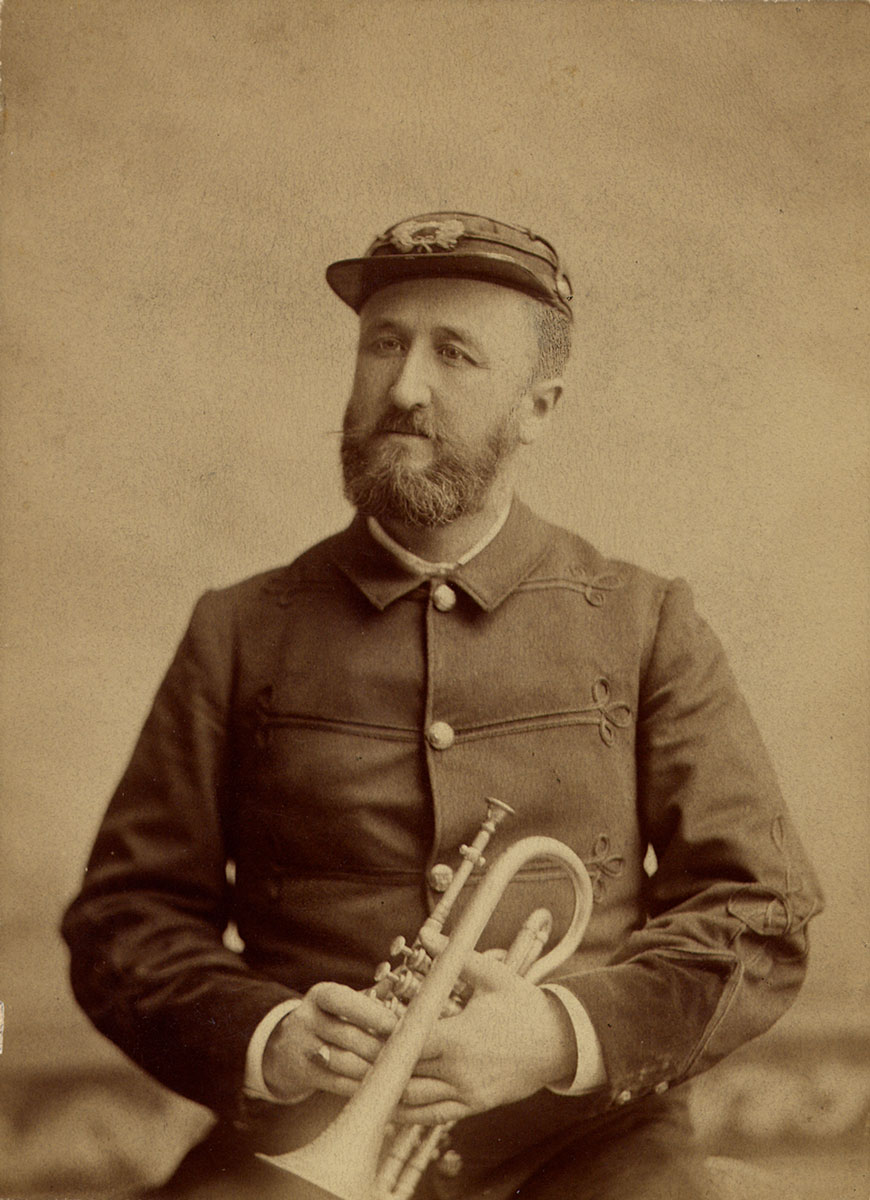
George Ives in his Bandmaster’s Uniform, c. 1890. Photograph. (Charles Ives Papers MSS 14, photograph courtesy of Irving S. Gilmore Music Library, Yale University)
As a young man, George had led the Second Connecticut Heavy Artillery Band, a formative experience and one greatly respected by his son. Expertly cradling his cornet, Ives senior has a quizzical look, refusing the formal frontality typical of the genre. The bandleader seems to be taking a breath, about to speak; is there perhaps a hint of sardonic wit about his whiskered mouth? Among George’s experiments, which included toying with quarter tones, the most notorious was to direct two bands, playing pieces in different keys to march past each other, creating a sound of (in Charles’s phrase) “cacophonous conflict,” a clear precedent for the younger Ives’s most outlandishly joyous musical mash-ups. An early death in 1894 left this youthful and vigorous image, zealously preserved by his son, as George’s final memorial.
An albumen print of the Ives houses was made in the summer of 1892, at a time when Charlie, at 17, was a popular school football player, soon to head off to Hopkins Grammar School in New Haven and thence to Yale.
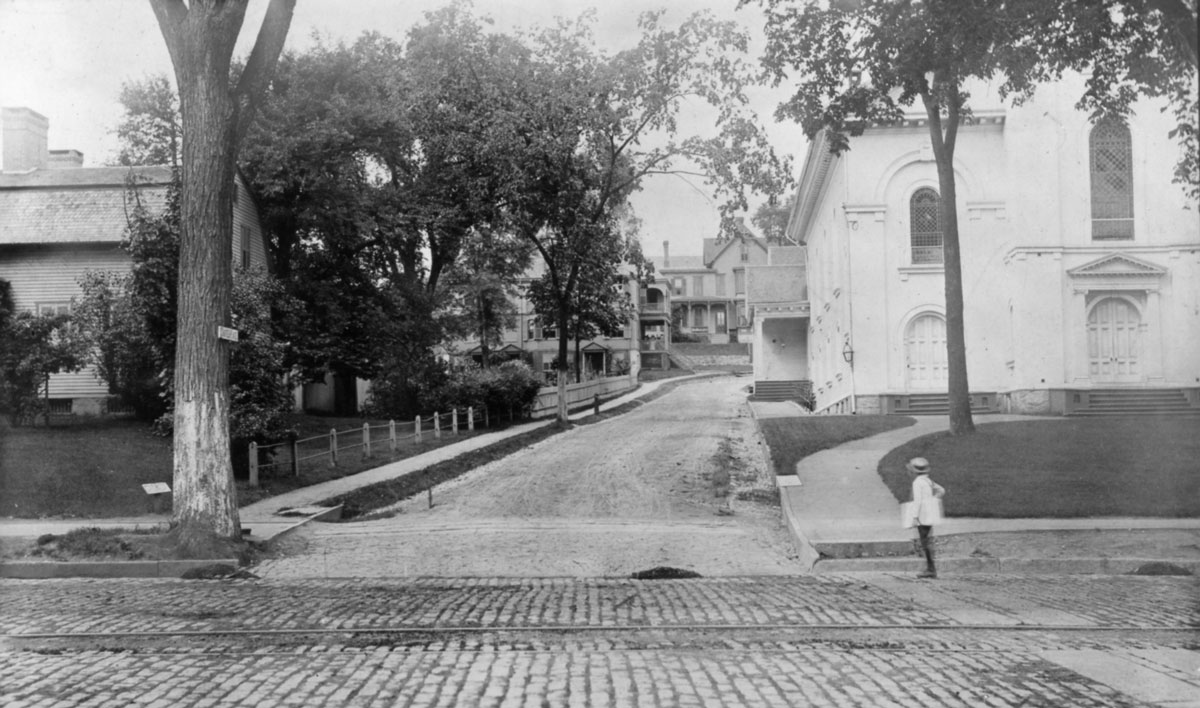
Danbury, Chapel Place viewed from Main Street, 1892. Photograph. (Charles Ives Papers MSS 14, photograph courtesy of Irving S. Gilmore Music Library, Yale University)
A precocious organist and composer, the boy had recently performed his own Variations on America in a concert at Brewster, New York. The following year he would encounter modernity at its most unapologetic at the electrically lit World’s Columbian Exposition. Preserved among the Ives papers in the Yale Music Library, this faded image of a corner of Danbury captures the spirit of the place. It does so with the revelatory magic that attached to the photograph in Ives’s youth, when the medium was but half a century old. Chapel Place is viewed from Main Street: on the left, the modest home in which Ives was born sits demurely among trees and shrubs; beyond it can be glimpsed the larger house, converted from the family barn, in which he lived as a teenager.
The photograph marked a radical divergence from earlier forms of popular representation seen on the walls of Victorian America, such as silhouettes cut from paper, or Currier and Ives’s hand-colored lithographic prints, for example, American Homestead Spring.
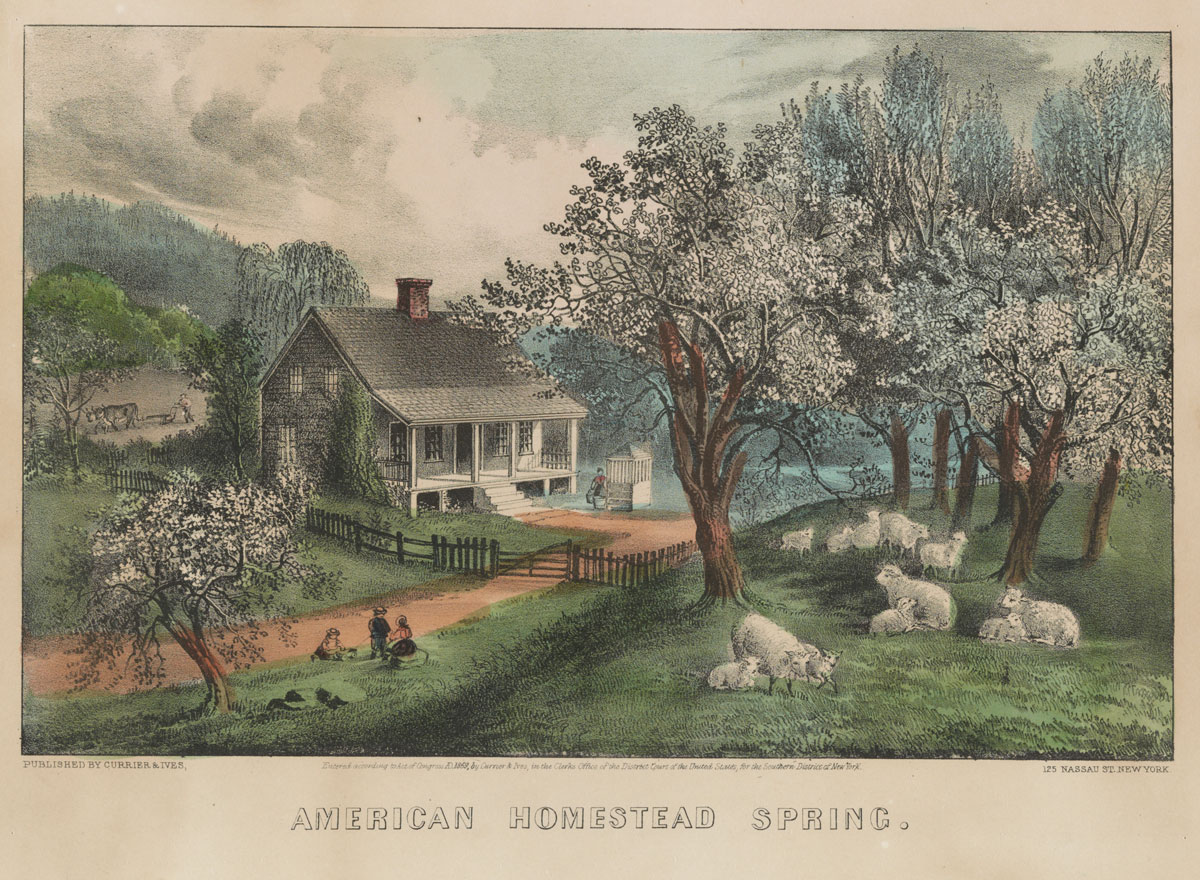
American Homestead: Spring, c. 1869, Currier & Ives. Hand-tinted lithograph. (Library of Congress)
Imagery of this kind hovers in Ives’s pictorial imagination in the way that Stephen Foster’s songs are ever-present in his musical vocabulary, as fondly remembered half-truths of an earlier era. Every aspect of the Currier and Ives lithograph reinforces the theme of fecundity, safety, homeliness. But unlike the print’s sugary idyll, the photograph of the homestead at Danbury (much like Ives’s later scores) incorporates a multitude of incidental, miscellaneous, quotidian details. The lens registered the undulations of worn brick pavement and the soil in the road, likely the dung of horses such as those driven at speed by Charles’s eccentric uncle Isaac. Most poignant is the slim figure of a child, holding a portfolio, doubtless told by the photographer to stand motionless as the plate was exposed. Our surrogate in the image, this small white-clad figure allows the viewer by association to see, to hear, to smell a lost world with the uncanny smack of truthfulness that also marks out Ives’s compositions. Our avatar contrasts vividly with the rich darkness of the mossy lawn behind, like a figure in a dream; above rises the severe geometric bulk of the First Congregational Church, where the Ives family worshipped.
The photograph sits today in an acid-free solander box in a silent, air-conditioned archive: but the juxtaposition of large white-painted church and small residence irresistibly conjures a soundscape: surely, from the quiet wooden interior of the homestead, the echoing cadence of hymns could be heard from services across the lane. Such experiences might account for Ives’s repeated evocation of the foursquare plod of Victorian hymnody, which so often penetrates the complex carapace of his experimental scores. Just as the sound of many congregations and denominations in full voice must have echoed though Danbury on a Sunday morning, communal singing bursts forth through the eclectic texture of scores including the Second and, spectacularly, Third Symphonies, written long after Ives had stepped aside from formal religious observance and ceased his work as a professional organist, embracing a double life as insurance executive and visionary composer.
Picturesque and Sublime by the Housatonic
Though Danbury was a small industrial city, indelibly marked by environmental pollution, strikes, and social upheaval, Ives’s musical evocations are overwhelmingly pastoral in mood. With a brisk walk, Victorian Danburians could be amid countryside that was palpably bucolic. A close reading of the Transcendentalists was formative for Ives’s understanding of the numinous in nature. Emerson’s “Nature” featured in an essay he wrote in his senior year at Yale for William Lyon Phelps’s celebrated course on American literature. A lifetime later, Ives returned to the Transcendentalists in the first section of his Essays before a Sonata, an aesthetic manifesto published to accompany his Second Piano Sonata, Concord, Mass. 1840–60, whose muscular first movement is titled “Emerson.”
Ives’s view of nature, like that of his literary heroes, was fundamentally shaped by looking; visual contemplation would lead to spiritual truth. For Emerson, as for his English contemporary John Ruskin, familiar natural forms could reveal the profundities that lie behind or beneath them. Ruskin first formulated his aesthetic theory by looking closely at the work of J. M. W. Turner. It is no surprise that on his first trip abroad, to England in 1924, Ives headed to the Tate Gallery. There he steeped himself in Turner’s work, which he revered more than that of any other artist. Turner’s early watercolors captured a profusion of detail within the comforting framework of the picturesque; but one suspects it was the later, visionary canvases that Ives admired. Like Ruskin, he would have been aware that a work like Turner’s Norham Castle, Sunrise, though apparently unfinished, inchoate and hazy, was rooted in a lifetime of close observation.
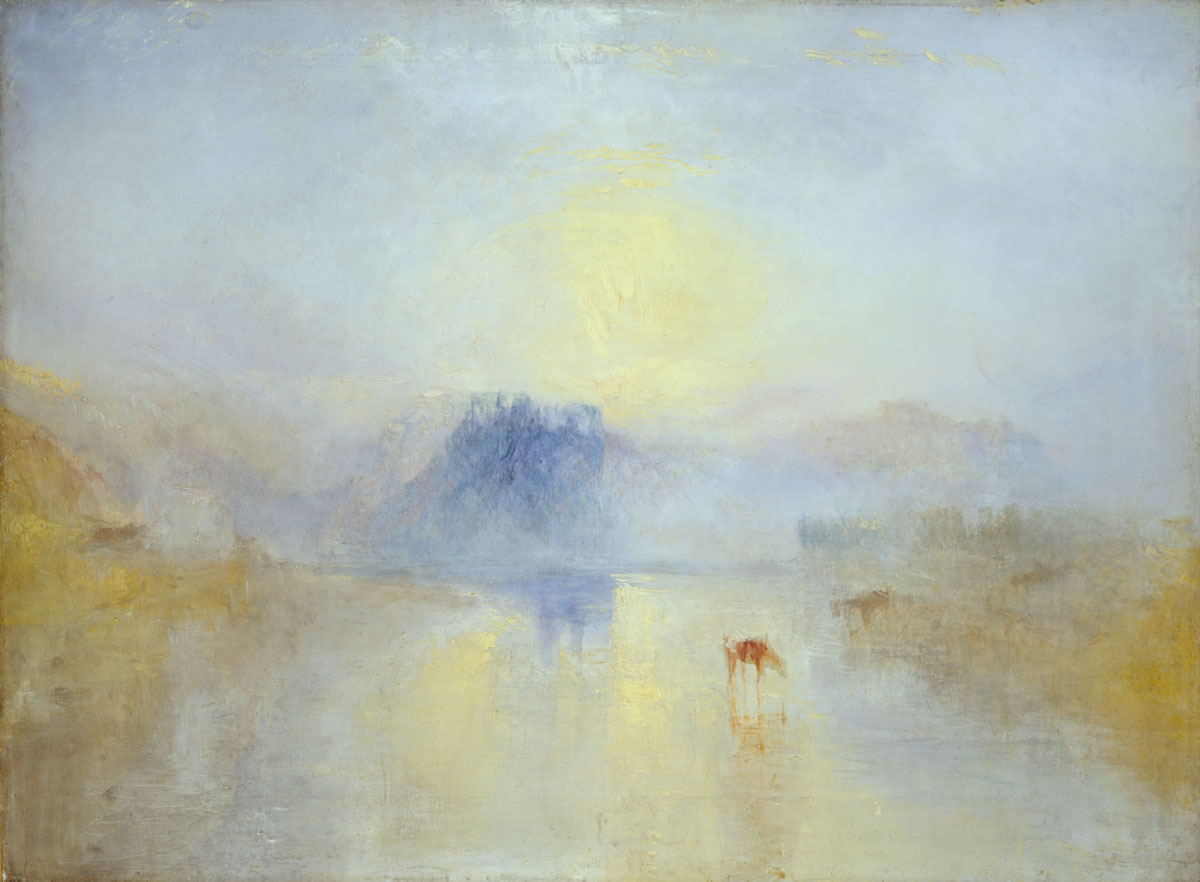
Norham Castle: Sunrise, 1845, Joseph Mallord William Turner. Oil on canvas. (Tate)
“The higher Emerson soars, the more lowly he becomes,” wrote Ives, and the same is true of Turner, who, Ruskin complained, retained a lifelong fondness for “black barges, patched sails, and every possible condition of fog.” The affinity between the composer and the long-dead English painter surely rested upon their shared insistence on solid earthy matter, on the real, rendered truly, but without excessive detail or flashy finish. Ives quotes Ruskin on the power that all great pictures have, which “depends on the penetration of the imagination into the true nature of the thing represented.” When Ives described Emerson as “a seer painting his discoveries in masses with any color that may lie at hand—cosmic, religious, human, even sensuous; a recorder freely describing the inevitable struggle in the soul’s uprise,” he could have been describing Turner, or himself.
Generations of American painters, from Thomas Cole through Frederic Church to Winslow Homer, carried Turner’s project into the New World. When Ives described a natural scene in sound, it was with pictorial concerns in mind—pictorial concerns defined by this tradition. “The Housatonic at Stockbridge” would become the final movement of Ives’s first orchestral set, Three Places in New England. It was rooted, like landscapes of the American sublime, in a particular moment of intense observation; in Ives’s case, a walk by the river with his new wife, Harmony Twichell Ives, in 1908. “The grand old River,” Ives recalled in old age, “is one [of] nature’s masterpieces, and has been an inspiring friend of Mr. I. from his boyhood days.” The short orchestral piece “could reflect … the moving River, its landscapes & Elm trees on its way to the adventurous sea.” The muted upper strings should, he added, “be heard rather subconsciously as a kind of distant background of an autumn sky and mists seen through the trees over a river valley.” These words evoke a sketch in watercolor made on the spot, worked up in the studio into a finished composition, as was the practice of Turner, Cole, and Church, whose early canvas Autumn, 1856 captures something of the same effect.

Autumn, 1856, Frederic Church. Oil on canvas. (Olana, New York State Historic Site)
The hues of Ives’s opening are those of a hushed picturesque, in a land of timeless stasis. Long drawn out and tonally ambiguous lines in the strings give a sense of the slow-moving river’s muddy path, a vision of horizontal progress through space. There is none of the Gallic iridescence that Claude Debussy or Maurice Ravel would bring to their depictions of watery depths. A solemn melody emerges in the second violas, horn, and English horn, and is harmonized with triads in the lower strings and brass, hinting at the distant sound of a hymn. Subtle shifts in the soundscape suggest, first, the gentle rippling and, finally, a move into more turbid waters.
As the movement rises to a climax, we enter the realm of the sublime, defined in American art by Church’s blood-red and brimstone-yellow canvas Twilight in the Wilderness.
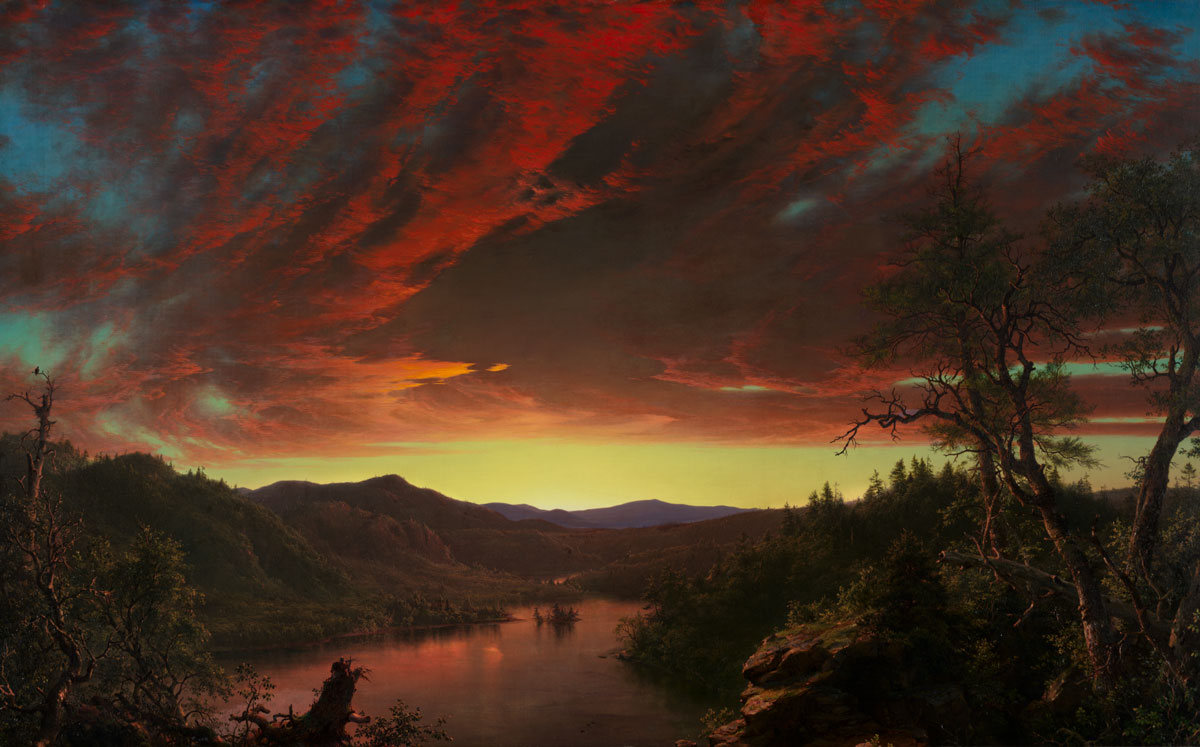
Twilight in the Wilderness, 1860, Frederic Edwin Church. Oil on canvas. (Cleveland Museum of Art)
“The Housatonic at Stockbridge” likewise insists on a distinctively American kind of sublimity, fashioned from local materials. As Ives reaches a climax, we move from past to present. In many of Turner’s defining essays in the sublime, such as Rain, Steam and Speed (1844), in which a locomotive crosses a viaduct, spitting fire, technology represents both a violation of the natural landscape and a bringer of new energies. Ives, too, was acutely aware of the intrusions of technology, setting in 1913 his own text for a song “The New River”:
Down the river comes a noise!
It is not the voice of rolling waters;
It’s only the sounds of man:
Phonographs and gasoline, dancing halls and tambourine,
[Human beings gone machine.]
Killed is the blare of the hunting horn;
The River Gods are gone.
In 1911, The New York Times could write of the “calamity” that would result from plans to build a dam at the Zoar Bridge, a key water catchment area for the Housatonic. The dissonance and pandemonium that swiftly overpower Ives’s picturesque idyll in “The Housatonic at Stockbridge” surely portend not merely a journey downstream, but the transformative and fatal powers of the modern.
Aunt Sarah and the Modernity of Vernacular Objects
Something like a photographic negative of Ives’s preoccupations and dilemmas can be found in the peculiar figure of Wallace Nutting, who graduated from Harvard in 1887, and whose early career as a Congregational minister came to a sudden end with the onset of “neurasthenia,” the form of neurosis that also afflicted Ives. Recovering from mental illness, Nutting turned to photography in the picturesque tradition, with a focus on small-town rural New England, which he described as “old America.”

Between Sunlight and Firelight, c. 1910–1920, Wallace Nutting. Hand-tinted photograph. (Historic New England)
Ives’s recourse to the local past generated works of exceptional formal originality and poetic intensity, and he strictly separated moneymaking work from creative practice. Nutting, by contrast, cashed in on nostalgia and claimed to have sold 10 million hand-colored prints. His “Colonials” were staged in historic interiors with models wearing gracious 18th-century costumes. Restoring historic houses in Wethersfield, Connecticut, he pioneered the “period room” display, in which historic spaces were dressed with colonial furniture, often reproduced using modern techniques. Period rooms were central to the Metropolitan Museum of Art’s new American Wing, which opened in 1924. The galleries emphasized an elite Anglo-Saxon and Protestant lineage, a formulation of nostalgia that easily shaded over into the reactionary, anti-immigrant politics shared by some of the museum’s wealthy patrons. Unlike Nutting’s slick presentation of American history as genteel kitsch, or the American Wing’s paean to Georgian gentility, Ives’s rough-hewn formal innovations emerged from local knowledge and lived experience.
This revival of interest in historical American objects at the moment of Ives’s artistic maturity also produced a different narrative. New materials came to the fore at this time, under the influence of the Arts & Crafts Movement, and in particular, of William Morris’s revival of interest in what became known as folk art or craft. Simple American rural farmhouse furniture and architecture inspired Gustav Stickley to create a new line of unadorned wooden furniture, which he promoted in The Craftsman journal, first published in 1901. Collectors suddenly discerned aesthetic value in functional objects from farms and homesteads, lovingly made by their owners. Hooked and sewn rugs with bold geometric patterns, like so-called “crazy quilts,” could seem authentically American while also appealing to the burgeoning taste for the “primitive” in modernist circles. Formally innovative, these works broke all the rules of genteel decorative comportment. It was in this sense that Leonard Bernstein could describe Charles Ives as a “greatly gifted primitive.”
A “crazy quilt” now at the Metropolitan Museum is, like Ives’s works, full of direct references to the life of its maker, in this case Tamar Horton Harris North of North’s Landing, Indiana.
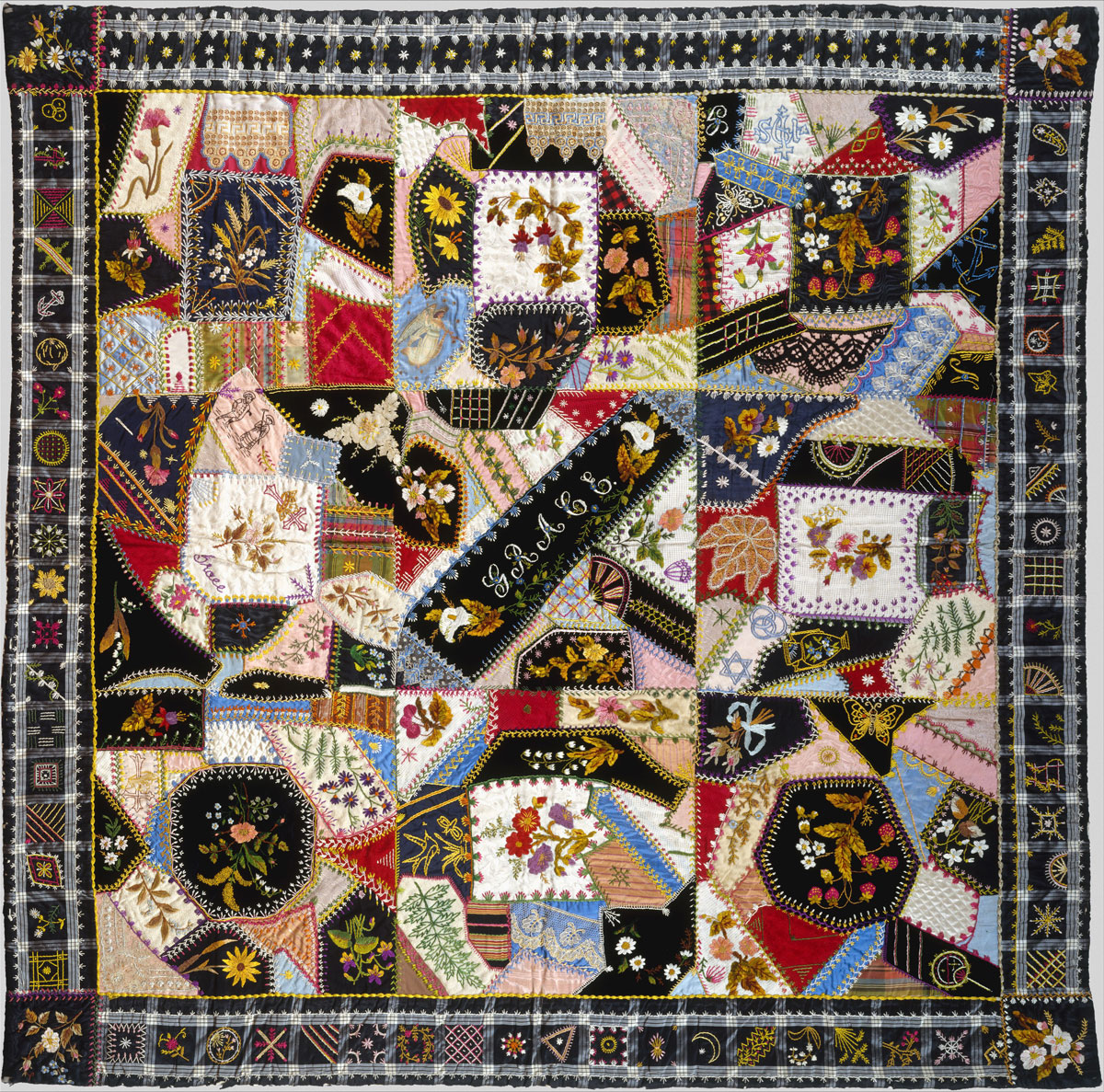
Quilt (or decorative throw), Crazy pattern, c. 1877, Tamar Horton Harris North. Silk, silk velvet, cotton, and cotton lace. (Metropolitan Museum of Art)
Commemorating the death of her 20-year-old daughter, Grace Gertrude North, the quilt consists of pieces of silk and silk velvet, with additional swatches of cotton and cotton lace, some of which may have been taken from Grace’s clothes. Its simple memorial iconography features an angel and Grace’s name with a calla lily to either side. The work is one of dizzying sophistication and vibrant formal energy, unique and specific to its time and place. Whereas a quilt and a symphony or tone poem are palpably different, and the life of a farmer’s wife may be completely unlike that of a university-educated insurance executive, there is nonetheless a kinship between Ives’s music and a wild, innovative textile like this one.
In “Essays before a Sonata” Ives makes a similar point:
If the Yankee can reflect the fervency with which “his gospels” were sung—the fervency of “Aunt Sarah,” who scrubbed her life away, for her brother’s ten orphans, the fervency with which this woman, after a fourteen-hour work day on the farm, would hitch up and drive five miles, through the mud and rain to “prayer meetin’”—her one articulate outlet for the fullness of her unselfish soul—if he can reflect the fervency of such a spirit, he may find there a local color that will do all the world good. If his music can but catch that “spirit” by being a part with itself, it will come somewhere near his ideal—and it will be American, too.
Quilting might well have been one of the activities an “Aunt Sarah” would undertake, and the “spirit” expressed in rural American crafts might align with Ives’s compositional practice. Certainly the local color is present in Grace’s memorial quilt; it is an inalienably American object. Here, too, is a refusal to follow established patterns, to conform to preordained canons of taste and procedure. And here is a fierce originality. These are, surely, the essential characteristics of the work of Charles Ives.

